
漢德百科全書 | 汉德百科全书
 Shaanxi Sheng-SN
Shaanxi Sheng-SN



 Anhui Sheng-AH
Anhui Sheng-AH
 China
China
 Gansu Sheng-GS
Gansu Sheng-GS
 Henan Sheng-HA
Henan Sheng-HA
 Jiangsu Sheng-JS
Jiangsu Sheng-JS
 Shaanxi Sheng-SN
Shaanxi Sheng-SN

 Vacation and Travel
Vacation and Travel
 Xinjiang Uygur Zizhiqu-XJ
Xinjiang Uygur Zizhiqu-XJ


 Beijing Shi-BJ
Beijing Shi-BJ
 Gansu Sheng-GS
Gansu Sheng-GS

 History
History
 L 1000 - 1500 AD
L 1000 - 1500 AD
 Hebei Sheng-HE
Hebei Sheng-HE
 Heilongjiang Sheng-HL
Heilongjiang Sheng-HL
 Jilin Sheng-JL
Jilin Sheng-JL
 Liaoning Sheng-LN
Liaoning Sheng-LN
 Nei Mongol Zizhiqu-NM
Nei Mongol Zizhiqu-NM
 Ningxia Huizu Zizhiqu-NX
Ningxia Huizu Zizhiqu-NX
 Qinghai Sheng-QH
Qinghai Sheng-QH
 Shaanxi Sheng-SN
Shaanxi Sheng-SN
 Shanxi Sheng-SX
Shanxi Sheng-SX
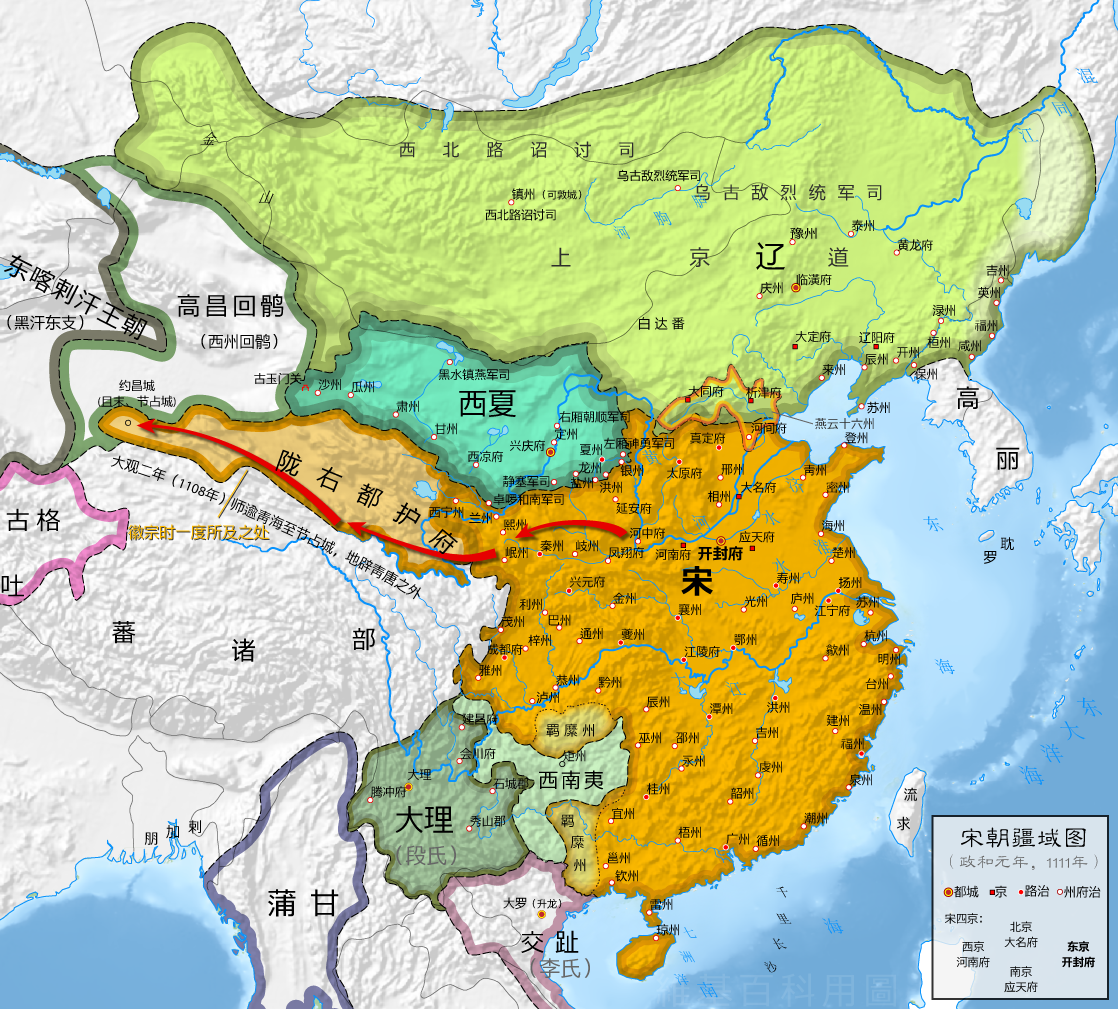
Die Liao-Dynastie (chinesisch 遼朝 / 辽朝, Pinyin Liáocháo) war eine Dynastie im Norden Chinas von 916 bis 1125. Das Herrscherhaus und ein Teil der Untertanen waren Angehörige des (proto-)mongolischen Volks der Kitan. Der Dynastie-Gründer war Abaoji († 926).
辽朝(907年-1125年),国号大辽,又称大契丹国(契丹国,契丹大字:![]() )[注 1],是中国历史上由契丹人建立的一个朝代,国祚210年[2]。
)[注 1],是中国历史上由契丹人建立的一个朝代,国祚210年[2]。
契丹族首领耶律阿保机吞并了契丹各个部落后,于916年称帝建国“契丹”。918年定都临潢府(今内蒙古巴林左旗南)。契丹屡次南下中原,946年阿保机之子耶律德光攻灭后晋后确定国号为“大辽”[注 2],983年改为“契丹”,1066年改为“大辽”[3],直到1125年3月26日为金朝所灭为止。除了辽朝之外,契丹族尚建立相关国家。1122年,天祚帝北逃夹山,耶律淳于辽南京被立为帝,史称北辽[3]。辽朝灭亡后,耶律大石西迁到中亚楚河流域,1132年建立西辽。1211年西辽被屈出律篡位,1218年被蒙古帝国所灭。
史学界对“契丹”含义最广为接受的说法是镔铁或刀剑之意。后来改国名为“辽”也是“铁”的意思,同时“辽”也是契丹人发祥地辽水的名字,以示不忘本之意。又因与南方的中原政权长期对峙,而称“北朝”,而称中原王朝为“南朝”[4]。辽朝926年灭渤海国,938年据燕云十六州,后灭后晋,自居为继承后晋的中原正统,即使之后退回北方。依据五行德运说的五行相生规律,后晋的“木”德之后为“水”德,因此辽朝以水为德运,并相应以黑色为正色。[5]
辽朝全盛时期疆域东到日本海,西至阿尔泰山,北到额尔古纳河、大兴安岭一带,南到河北省南部的白沟河。契丹族本是游牧民族,辽朝皇帝使农牧业共同发展繁荣,各得其所,建立独特的、比较完整的管理体制。辽朝将重心放在民族发祥地,为了保持民族性将游牧民族(契丹人)与农业民族(汉人)分开统治,主张因俗而治,开创出两院制的政治体制。并且创造契丹文字,保存自己的文化。此外,吸收渤海国、五代、北宋、西夏及西域各国的文化,成效地促进辽朝政治、经济和文化各个方面发展。辽朝的军事力量与影响力涵盖西域地区,因此在唐朝灭亡后中亚、西亚与东欧等地区常将辽朝(契丹,英语作Cathay)当做中国,[6]。
遼(りょう、簡体字:辽、拼音:Liáo)は、遼朝(りょうちょう)ともいい、内モンゴルを中心に中国の北辺を支配した契丹人(キタイ人)耶律氏(ヤリュート氏)の征服王朝。916年から1125年まで続いた。中原に迫る大規模な版図(現在の北京を含む)を持ち、かつ長期間続いた最初の異民族王朝であり、いわゆる征服王朝(金、元、清が続く)の最初とされる。ただし、後の3つの王朝と異なって中原を支配下にはおいていない。
The Liao dynasty (/ljaʊ/;[5] Khitan: Mos Jælud; traditional Chinese: 遼朝; simplified Chinese: 辽朝; pinyin: Liáo cháo),[6] also known as the Liao Empire, officially the Great Liao (大遼; 大辽; Dà Liáo), or the Khitan (Qidan) State (Khitan: Mos diau-d kitai huldʒi gur),[7] was an empire in East Asia that ruled from 907 to 1125 over present-day Northern and Northeast China, Mongolia and portions of the Russian Far East and North Korea.[8] The empire was founded by Yelü Abaoji, Khagan of the Khitans around the time of the collapse of Tang China and was the first state to control all of Manchuria.[9]
Almost immediately after its founding, the Khitan Empire began a process of territorial expansion, with Abaoji leading a successful conquest of Balhae. Later emperors would gain the Sixteen Prefectures by fueling a proxy war that led to the collapse of the Later Tang (923–936) and would establish tributary relationships with Goryeo after losing in Goryeo–Khitan Wars (1018) against Goryeo.[10] In 1004, Liao Dynasty launched an imperial expedition against the Northern Song. After heavy fighting and large casualties between two countries, the two sides worked out the Chanyuan Treaty. Through the treaty Liao forced the Northern Song to recognize them as peers.
Tension between traditional Khitan social and political practices and Chinese influence and customs was a defining feature of the dynasty. This tension led to a series of succession crises; Liao emperors favored the Chinese concept of primogeniture, while much of the rest of the Khitan elite supported the traditional method of succession by the strongest candidate. So different were Khitan and Chinese practices that Abaoji set up two parallel governments. The Northern Administration governed Khitan areas following traditional Khitan practices, while the Southern Administration governed areas with large non-Khitan populations, adopting traditional Chinese governmental practices.
Differences between Chinese and Khitan society included gender roles and marital practices: the Khitans took a more egalitarian view towards gender, in sharp contrast to Chinese cultural practices that segregated men's and women's roles. Khitan women were taught to hunt, managed family property, and held military posts. Many marriages were not arranged, women were not required to be virgins at their first marriage, and women had the right to divorce and remarry.
The Liao dynasty was destroyed by the Jurchen-led Jin dynasty in 1125 with the capture of Emperor Tianzuo of Liao. However, the remnant Khitan, led by Yelü Dashi, established the Qara Khitai (Western Liao dynasty), which ruled over parts of Central Asia for almost a century before being conquered by the Mongols. Although cultural achievements associated with the Liao dynasty are considerable, and a number of various statuary and other artifacts exist in museums and other collections, major questions remain over the exact nature and extent of the influence of the Liao Khitan culture upon subsequent developments, such as the musical and theatrical arts.
La dynastie Liao (chinois simplifié : 辽朝 ; chinois traditionnel : 遼朝 ; pinyin : ; Khitan : Mos Jælud)1, également connue sous le nom d'Empire Khitan (chinois simplifié : 契丹国 ; chinois traditionnel : 契丹國 ; pinyin : ; Khitan : Mos diau-d kitai huldʒi gur)2, est un empire d'Asie orientale qui a régné sur la Mongolie, une partie de la Russie orientale et du nord de la Chine continentale entre 907 et 1125. Elle a été fondée par le Khagan Khitan Yelü Abaoji à la suite de la chute de la dynastie chinoise Tang.
Bien que couvrant essentiellement les steppes mongoles et quelques provinces du Nord de la Chine actuelle, la majorité de la population sous le contrôle de la dynastie était d'origine Chinoise Han. Le gouvernement Khitan a donc instauré un système administratif inédit visant à prendre en compte les spécificités de chaque partie du territoire, afin de mieux contrôler les populations locales. Cette période fut également une étape importante pour les Khitans, qui formalisent leur langue écrite à cette époque et commencent à intégrer de plus en plus les coutumes traditionnelles des Chinois Han.
L'empire a été détruit par les Jürchens de la dynastie Jin en 1125. Toutefois, certains survivants du peuple Khitan, menés par Yelü Dashi, ont établi la dynastie des Liao occidentaux. Connue également sous le nom de Khanate Kara-Khitans, cette dynastie a régné sur des parties de l'Asie centrale pendant près d'un siècle, avant d'être conquise à son tour par l'armée mongole de Genghis Khan.
La dinastia Liao (cinese tradizionale: 遼朝; cinese semplificato: 辽朝; pinyin: Liáo Cháo), 907-1125, conosciuta anche come impero Kitai (契丹國 / 契丹国 / Qìdān Guó), fu una dinastia che regnò sulle regioni della Manciuria, della Mongolia e su parte della Cina settentrionale. Fu fondata dalla tribù Yelü (耶律 Yēlǜ) del popolo Kitai nell'ultimo periodo della dinastia Tang, anche se il primo sovrano, Ābǎojī (阿保機 / 阿保机), proclamò il primo periodo di regno solo nel 916.
Nel 947 (o secondo altre fonti nel 938) l'imperatore Yelü Ruǎn adottò ufficialmente il nome "Liáo" (formalmente "Grande Liáo"). Abbandonato nel 983, il nome fu poi ripreso nel 1066.
Il regno dei Liao fu distrutto dagli Jurchi della dinastia Jīn nel 1125. I superstiti, guidati da Yelü Dashi, fondarono la dinastia Liao occidentale 1125-1220 o Kara Khitay, che sopravvisse fino all'arrivo dell'esercito mongolo di Gengis Khan.
La dinastía Liao (chino tradicional: 遼朝, chino simplificado: 辽朝, pinyin: Liáo Cháo, Wade-Giles: Liao2-Ch'ao2, kitán: Mos Jælut),12 907-1125, también conocida como Imperio kitán (契丹國 pinyin: Qìdān Guó, kitán: Mos diau-d kitai huldʒi gur)3 fue una dinastía china, de origen extranjero, que gobernó gran parte del nordeste del territorio chino actual.
Los kitán, uno de los grupos étnicos tunguses, de origen altaico, que habitaban hace siglos en la actual Manchuria, fundaron en el año 907 un estado que recibió inicialmente el nombre de Estado Kitán. Más adelante, tras conquistar el norte de China, el estado asumió formas de gobierno de estilo chino tomando el nombre dinástico de Liao, por el río del mismo nombre (en la actual provincia china de Liaoning) de su tierra ancestral. El imperio de los Liao convivió con la dinastía Song, al sur, y con el Imperio Tangut (o Xia Occidental), que gobernaba parte del noroeste chino.
El imperio de los kitán cayó definitivamente en el año 1125, derrotado por otro pueblo altaico, los yurchen, que conquistaron el territorio de los Liao, y fundaron su propia dinastía, la Jin.
Del nombre "kitán" deriva el nombre "Catay" con el que se conoció a China en Europa durante la Edad Media. El nombre actual de China en ruso (Kitái), mongol (Qitad) y uigur (Hitay) tiene también este mismo origen.
Ляо (монг. Кидан улс, кит. трад. 遼朝, упр. 辽朝, пиньинь: Liao chao, палл.: Ляо Чао) — государство кидань-монголов, которое занимало просторы Северо-Восточного Китая с момента основания киданьской государственности племенным вождём Абаоцзи (Амбагай) в 907 году до мятежа чжурчжэней в 1125 году. Столицы — Шанцзин (верховная, ныне Хуэйнинфу), Ляоян (восточная), Датун (западная), Наньцзин (южная, в районе современного Пекина).
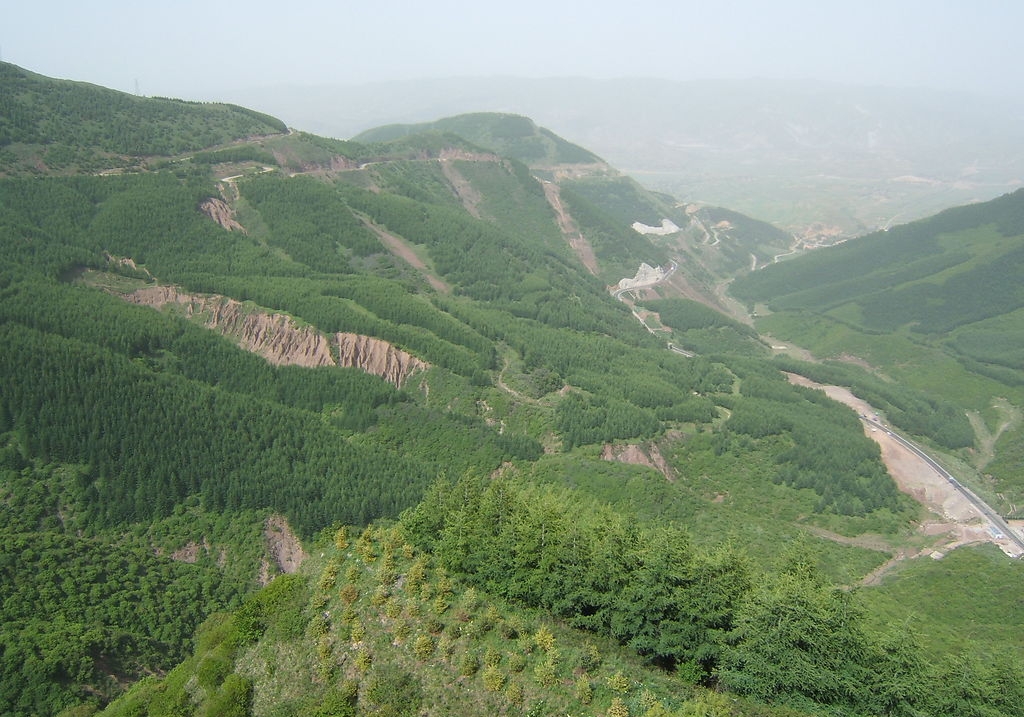
Das Liupan-Gebirge (Liupan Shan 六盘山, auch Liupan Shanmai 六盘山脉 oder (für den südlichen Teil) Long Shan 陇山) in Süd-Ningxia und Ost-Gansu ist einer der wenigen von Norden nach Süden verlaufenden Gebirgszüge Chinas im Grenzgebiet der chinesischen Provinzen Ningxia, Gansu und Shaanxi. Es ist ca. 240 km lang und bildet die Wasserscheide zwischen den Flüssen Wei He 渭河 und Jing He 泾河. Sein Hauptgipfel ist der Migang Shan 米缸山 an der Grenze von Jingyuan 泾源 und Longde 隆德 mit 2.942 Metern.


 Anhui Sheng-AH
Anhui Sheng-AH
 China
China
 Fujian Sheng-FJ
Fujian Sheng-FJ
 Grüntee
Grüntee
 Guangxi Zhuangzu Zizhiqu-GX
Guangxi Zhuangzu Zizhiqu-GX
 Guizhou Sheng-GZ
Guizhou Sheng-GZ
 Henan Sheng-HA
Henan Sheng-HA
 Hubei Sheng-HB
Hubei Sheng-HB
 Hunan Sheng-HN
Hunan Sheng-HN
 Jiangsu Sheng-JS
Jiangsu Sheng-JS
 Jiangxi Sheng-JX
Jiangxi Sheng-JX
 Shaanxi Sheng-SN
Shaanxi Sheng-SN
 Sichuan Sheng-SC
Sichuan Sheng-SC
 Zhejiang Sheng-ZJ
Zhejiang Sheng-ZJ
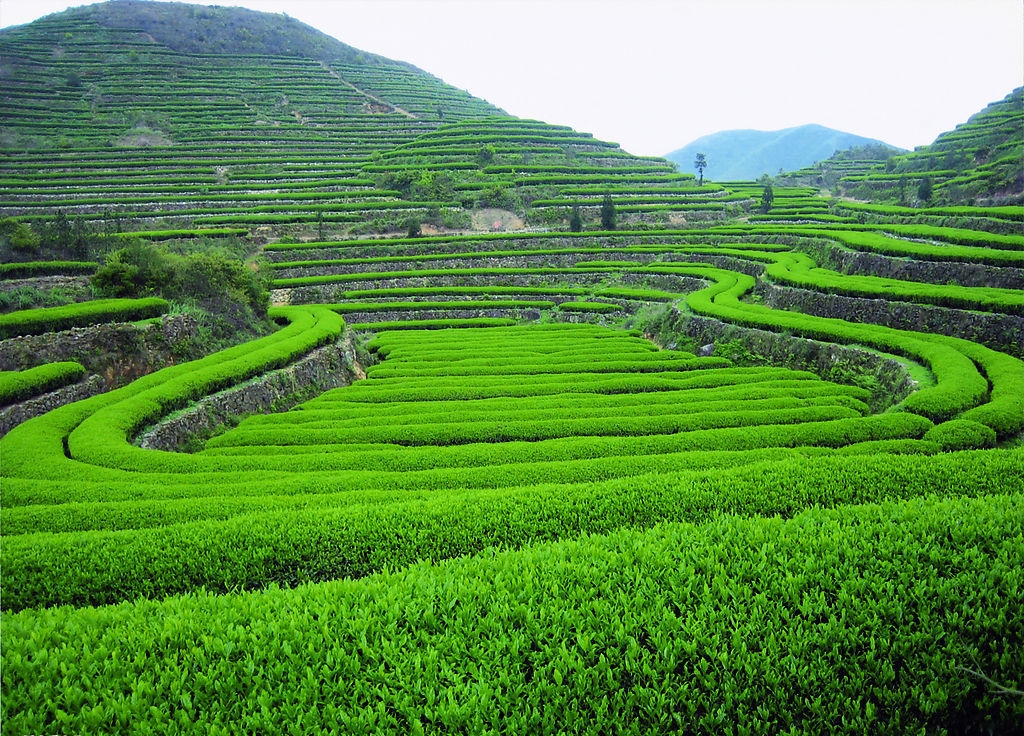
Grüntee wird aus den gleichen Pflanzen wie Schwarztee hergestellt; erst der Verarbeitungsprozess lässt den Unterschied entstehen.
Bei der Grünteeherstellung ist besondere Sorgfalt und Schnelligkeit gefragt, damit die Teeblätter nach der Ernte nicht oxidieren und so zu Schwarztee werden würden.
Daher werden sie sofort nach dem Pflücken entweder im Wasserdampf blanchiert - die japanische Methode - oder sie werden über Feuer getrocknet, wie es in China üblich ist.
Damit Ihr Grüntee gelingt, sollten Sie ihn niemals mit kochendem sondern stets mit etwas abgekühltem Wasser zubereiten. Außerdem ist er ergiebiger als schwarzer Tee, so dass Sie weniger Teeblätter benötigen.
Sollte der Tee Ihnen zu grasig oder spinatig sein, sollten Sie kühleres Wasser und etwas weniger Teeblätter verwenden. Weitere Tipps finden Sie bei unseren Zubereitungshinweisen.
(Quelle:http://www.teespeicher.de/Gruentee1.html)
Grüner Tee oder Grüntee (japanisch 緑茶 ryokucha, chinesisch 綠茶 / 绿茶, Pinyin lǜchá) ist eine Variante, Tee herzustellen. Die Teeblätter werden im Gegensatz zu schwarzem Tee nicht fermentiert. Wegen der anderen Verarbeitung werden für grünen Tee eher die Blätter von Camellia sinensis gegenüber der Varietät assamica bevorzugt, da sich die kleinblättrige, zartere Sorte besser eignet. Grüner Tee unterscheidet sich von schwarzem Tee unter anderem in der Zubereitung, im Geschmack, den Inhaltsstoffen und Wirkungen des Aufgusses.
绿茶是茶叶的一种。经过杀青、揉捻、干燥,大部分白毫脱落,热水浸泡后依种类呈淡绿色至黄绿色的茶汤。绿茶通过杀青工艺的不同可分为四种:炒青茶、蒸青茶、烘青茶、晒青茶。中国大陆与台湾在绿茶制作上以炒青为主;日本制作绿茶的方式则以蒸青为主。
炒青即将茶叶鲜叶在摄氏120度左右的铁锅中翻炒,使其水分散失,使其变得绵软,以便做形。传统工艺为徒手翻炒,来到现代为机械翻炒。绿茶没有焙火工序,所以可以称为生茶。[1]
中国大陆大部分名茶为绿茶,如 产于杭州西湖龙井、苏州洞庭山碧螺春、秦岭山脉北麓的紫阳富硒毛尖、汉中仙毫等。在清明之前,茶树刚发芽时采摘的,为“明前茶”也称为“莲心”或“银针”;在谷雨前采摘的,为“雨前茶”,茶叶已展开,也称为“旗枪”;在立夏前采摘的为“三春茶”,已经有两片叶展开,也称为“雀舌”;立夏后再采摘,叶片已变厚,为“四春茶”,也可称做“梗片”。
以青茶为主流的台湾,在新北市三峡区亦生产龙井茶及碧螺春等绿茶。
緑茶(りょくちゃ 拼音: )は、チャノキの葉から作った茶のうち、摘み取った茶葉を加熱処理して発酵を妨げたもの。もしくはそれに湯を注ぎ、成分を抽出した飲料のこと。
日本においては日本茶と同意に使われることが多い。日本茶(煎茶、ほうじ茶、抹茶など)はその多くが緑茶であり、日本でもっとも良く飲まれている茶である。中国茶もジャスミン茶として飲まれるものを含め緑茶に分類される物が主流で、中国や台湾で最も飲まれているのも緑茶である。烏龍茶やプーアル茶などは比較的特殊な部類に入り、産地を離れると余り飲まれず、日本人にとっての玉露や抹茶のような扱いになる。
日本では寿司や菓子とともに、あるいは食後に熱い茶を飲むのが一般的だった。近年、ペットボトル入りの緑茶の普及と健康志向の高まりで、水やジュースなどと同じ感覚で屋外や運動中に冷えた茶を飲む例が増えている。飲料メーカーは「ノンカロリー」「カテキン効果」などを宣伝文句に販売し、欧米やアジア諸国でも緑茶ブームが起きている。また、静岡では焼酎などを緑茶で割って「お茶割り」という名前で飲むことがあり、これを「静岡割り」として普及させようという動きもある。
Green tea is a type of tea that is made from Camellia sinensis leaves that have not undergone the same withering and oxidation process used to make oolong teas and black teas.[1] Green tea originated in China, but its production and manufacture has spread to many other countries in Asia.
Several varieties of green tea exist, which differ substantially based on the variety of C. sinensis used, growing conditions, horticultural methods, production processing, and time of harvest. Although there has been considerable research on the possible health effects of consuming green tea regularly, there is little evidence that drinking green tea has any effects on health.[2]
Un thé vert, en chinois simplifié : 绿茶 ; chinois traditionnel : 綠茶 ; pinyin : , et en japonais 緑茶 (Ryokucha) est un thé dont l'oxydation naturelle est rapidement stoppée après la cueillette. Il en résulte un thé non-oxydé maximisant ainsi sa teneur en EGCG et autres catéchines. Le thé vert contient également une concentration importante de L-théanine et une concentration de caféine inférieure à celle du thé noir. Une fois infusé, il peut être consommé chaud ou froid.
L'arrêt de l'oxydation des feuilles de thé, moment clé dans la production du thé vert, peut être obtenu selon deux méthodes : la méthode chinoise, dans laquelle les feuilles sont chauffées dans des cuves, et la méthode japonaise. Les thés produits selon la méthode japonaise1 bénéficient d'un arrêt de l'oxydation à la vapeur ce qui préserve davantage les propriétés des feuilles de thé qu'avec la méthode chinoise2. Ces thés de qualité se reconnaissent à la couleur foncée de leurs feuilles, à leur odeur d'algues une fois infusés et à leur goût herbacé et iodé. De nombreux producteurs, notamment au Japon3,4, se tournent aujourd'hui vers une production de thés verts conforme aux exigences de l'agriculture biologique.
Le thé vert est le thé le plus consommé en Chine, en Corée et au Japon. Il se répand aujourd'hui de plus en plus en Occident, où l'on boit traditionnellement plutôt du thé noir. Les différents terroirs, cultivars utilisés et modes de culture permettent d'obtenir des thés verts très différents. Si le sencha est le thé quotidien des Japonais, lors de la cérémonie du thé japonaise c'est du matcha, une poudre de thé vert broyé, qui est utilisé. Le matcha est désormais incorporé dans des pâtisseries et est l'ingrédient de base du matcha latte et du matcha frappé. Les thés verts les plus prestigieux comme le gyokuro (Japon) ou le long jing (Zhejiang, Chine) peuvent atteindre des prix importants sur le marché. Le thé vert intervient également dans la production de thé aromatisé comme le genmaicha qui lui associe du riz ou le gunpowder, qui est l'ingrédient de base du thé à la menthe.
Il tè verde (in cinese 綠茶T, 绿茶S, lǜcháP; in coreano 녹차?, nokchaLR, in giapponese: 緑茶 ryokucha?, in vietnamita Trà xanh) è una variante del tè ottenuta con foglie di Camellia sinensis (o Thea chinensis) che durante la lavorazione non devono subire alcuna ossidazione. Di origini cinesi come tutti i tè, per secoli è stato consumato in varie regioni asiatiche, dal Giappone al Medio Oriente. Negli ultimi anni ha trovato la sua diffusione anche in Occidente, dove per tradizione si consuma per lo più tè nero (più correttamente, rosso). A livello globale è la seconda varietà di tè più diffusa: dei 2,5 milioni di tonnellate di tè che si producono a livello mondiale, il 20% è rappresentato da tè verde (il 78% da tè nero, il 2% da tè blu).[1]
El té verde (chino tradicional: 綠茶, chino simplificado: 绿茶, pinyin: Lǜ chá) es un tipo de té Camellia sinensis que no ha sufrido una oxidación durante su procesado, a diferencia del té negro, ya que las hojas se recogen frescas y después de someterse al secado, se prensan, enrollan, trituran y finalmente se secan. El té verde supone entre una cuarta y una quinta parte del total de té producido mundialmente. Los principales países productores de té verde son China, Japón y Vietnam.1Se ha hecho más popular en Occidente, que tradicionalmente toma té negro.
Зелёный чай — чай, подвергнутый минимальной ферментации (окислению).
И зелёный, и чёрный чай получают из листьев одного и того же чайного куста, однако различными способами. Зелёный чай предварительно часто фиксируется паром температуры 170—180 °C; окисление продолжается не более двух дней, после чего обычно прекращается нагревом (традиционно в горшках, как принято в Китае, или под паром, как принято в Японии) или вообще не проводится. Чай оказывается окислен на 3—12 %.
Многочисленные восточноазиатские сорта зелёного чая обладают заметными различиями, обусловленными условиями выращивания, сбора и обработки чайных листьев[1]. Зелёный чай происходит из Китая[2] и традиционно популярен в Азии (в Японии, Корее, на Ближнем Востоке). В более западных странах, где традиционно преобладает чёрный чай, рост популярности зелёного чая пришёлся на конец XX века.
 *Chinesisches Ritual
*Chinesisches Ritual
 Ding
Ding

 Art
Art
 *Chinese bronze art
*Chinese bronze art

 Art
Art
 CD - Chinese Art 11th Century BC - 771 BC
CD - Chinese Art 11th Century BC - 771 BC
 Nationales Palastmuseum Taipeh
Nationales Palastmuseum Taipeh
 Shaanxi Sheng-SN
Shaanxi Sheng-SN
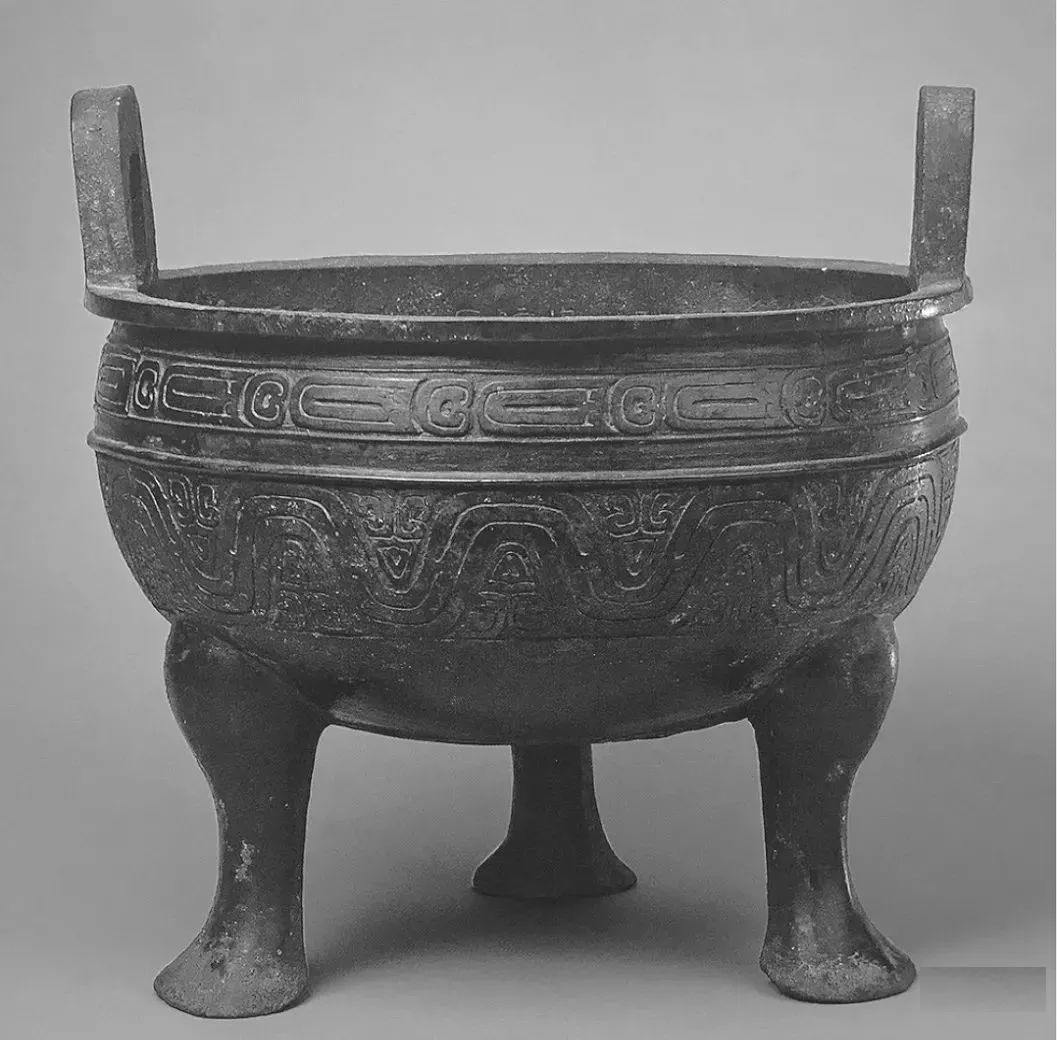
毛公鼎(Duke Mao Tripod),西周晚期青铜器,因作器者毛公而得名,清道光二十三年(1843年)出土于陕西岐山(今宝鸡市岐山县),现藏于台北故宫博物院。
高53.8厘米,腹深27.2厘米,口径47厘米,重34.700公斤。口饰重环纹一道,敞口,双立耳,三蹄足。
毛公鼎铭文长度接近五百字(有497字、499字、500字三说),在所见青铜器铭文中为最长。铭文的内容可分成七段,是说:周宣王即位之初,亟思振兴朝政,乃请叔父毛公为其治理国家内外的大小政务,并饬勤公无私,最后颁赠命服厚赐,毛公因而铸鼎传示子孙永宝。
毛公鼎,是西周宣王年间(前828年-前782年)所铸造的青铜鼎,腹内刻有500字金文册命书,字数为举世铭文青铜器中最多[1][2]。是西周散文代表作,其书法也是金文中最高等级[注 1],故有“抵得一篇《尚书》”[3]、晚清“四大国宝”[注 2]、“青铜三宝”、“海内三宝”[注 3]、民间“故宫三宝”之誉。现收藏于台北国立故宫博物院,被列为中华民国国宝。
Das Maoling-Mausoleum (auch Mao-Mausoleum oder Maoling) (chinesisch 茂陵, Pinyin Màolíng) bzw. Grab des Han-Kaisers Wudi (汉武帝墓, Hàn Wǔdì mù, englisch Maoling Mausoleum of Emperor Wudi of Han) ist das Grab des Han-Kaisers Wu (Hàn Wǔdì 汉武帝) bzw. „Wudi“ der Westlichen Han-Dynastie, der von 141-87 v. Chr. regierte. Es ist das größte der „Fünf Mausoleen“ (wǔlíng 五陵) der Westlichen Han-Dynastie (Xi Han wuling 西汉五陵) und wird auch als „Pyramide des Ostens“ (东方金字塔) bezeichnet.[1]
Das Grab liegt 40 km entfernt von der Provinzhauptstadt Xi’an im Dorf Maoling von Nanwei im Nordosten des Gebiets der heutigen Stadt Xingping (兴平市), einer kreisfreien Stadt der bezirksfreien Stadt Xianyang der Provinz Shaanxi in der Volksrepublik China.
Der Bau der Grabanlage begann im Jahr 139 v. Chr. und dauerte 53 Jahre. Die das Grab umgebende Mauer umfasst eine nahezu quadratische Grundfläche. Die Ost-West-Ausdehnung beträgt 431 m und die Nord-Süd-Ausdehnung 415 m. Die Mauer ist 5,8 Meter dick. In der Mitte eines jeden Mauerabschnitts befindet sich ein Tor. Das Grab selbst hat die Form einer stumpfen Pyramide mit einer Höhe von 46,5 m und einer größten Ausdehnung am Sockel von 240 m. Nach historischen Überlieferungen soll der Kaiser ein Drittel der Steuereinnahmen für den Bau der Grabstätte und deren Beigaben, die heute im Moaling Museum ausgestellt sind, genutzt haben.[2][3]
Rund um das Mausoleum befinden sich mehr als 20 weitere Gräber der Frauen und Konkubinen des Kaisers sowie der Minister. Zu diesen Nebengräbern gehören das Grab des Generals Huo Qubing, das Grab des Generals Wei Qing und das Grab von Jin Midi, die etwa einen Kilometer östlich vom Hauptgrab entfernt sind. Hier befindet sich auch das Maoling-Museum.
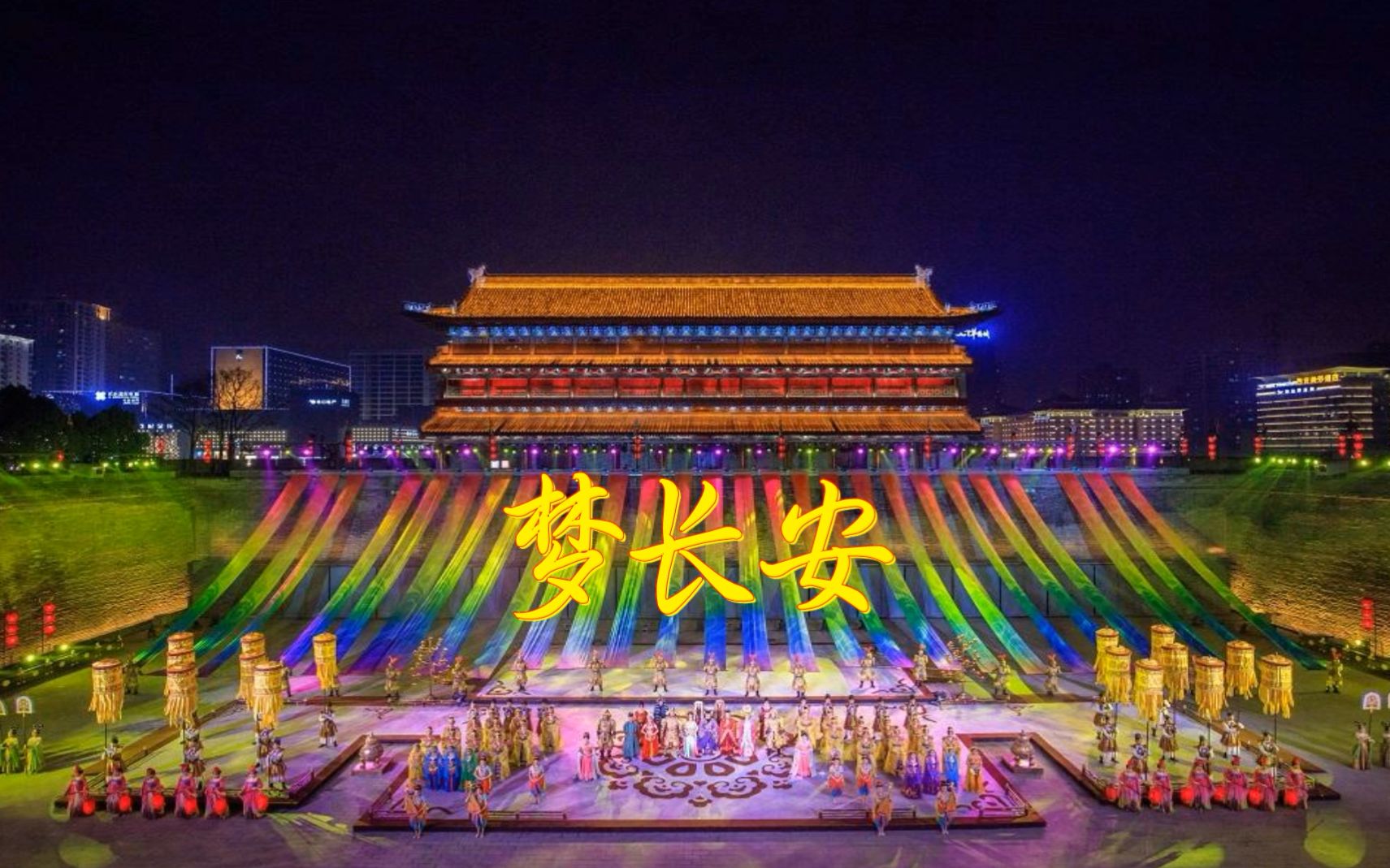
 Architecture
Architecture
 Review
Review
 Transport and traffic
Transport and traffic
 Geography
Geography
 Companies
Companies
 Eat and Drink
Eat and Drink
 Performing Arts
Performing Arts
 Traditions
Traditions